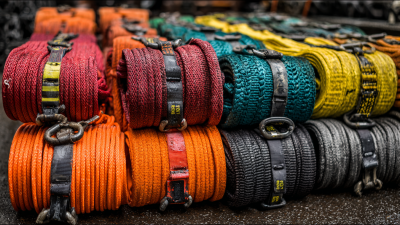Webbing straps are versatile and durable tools used extensively in various industries for securing loads, outdoor activities, and everyday applications. According to the report by Grand View Research, the global market for webbing is projected to reach USD 4.92 billion by 2025, reflecting a significant increase in demand across sectors such as construction, transportation, and outdoor recreation.

These straps, often made from synthetic fibers like nylon or polyester, are favored for their high tensile strength and resistance to abrasion and weather conditions. In daily life, webbing straps can be seen in applications ranging from securing luggage and mounting gear in outdoor sports to safety harnesses in construction and recreational activities.
Understanding the functionality and proper use of webbing straps can enhance safety and efficiency in both personal and professional settings, making it an essential topic to explore.
Webbing straps are versatile, strong fabric strips commonly utilized in various applications, ranging from outdoor gear to industrial uses. Defined as a flat woven textile strip, webbing typically consists of materials such as nylon, polyester, or polypropylene, chosen for their durability and resistance to environmental factors. According to a study by Transparency Market Research, the global webbing products market is expected to reach approximately $4 billion by 2026, driven by increasing demands in sectors such as automotive, aerospace, and outdoor activities.

The composition of webbing straps plays a crucial role in their performance. For instance, nylon webbing offers exceptional strength and elasticity, making it ideal for climbing and military applications, while polyester webbing is favored for its UV resistance and low stretch, suitable for applications like outdoor camping gear and luggage. Industry experts highlight that the tensile strength of high-quality webbing straps can exceed 6,000 pounds, which underscores their reliability in critical situations. As the demand for safety and efficiency continues to rise, understanding the composition and appropriate application of webbing straps becomes increasingly important in everyday life.
Webbing straps are versatile tools widely used in various everyday activities, serving both functional and recreational purposes. According to a report by Grand View Research, the global market for webbing products is expected to reach $6.5 billion by 2025, reflecting the growing demand across multiple sectors. One of the most common ways these straps are utilized is in outdoor activities such as camping and hiking. They are often used for securing gear, such as tents and backpacks, ensuring that items stay in place and reducing the risk of damage while on the move.
In addition to outdoor pursuits, webbing straps are frequently employed in transportation and logistics. They play a crucial role in securing cargo within trucks and trailers, minimizing the chance of shifting during transit. The American Transportation Research Institute suggests that improper load securing contributes significantly to road accidents, highlighting the importance of reliable webbing straps. Furthermore, these straps are also essential in everyday household tasks, such as organizing tools in garages or bundling items for storage. Their strength, durability, and ease of use make webbing straps an indispensable asset in both recreational and practical scenarios.
When selecting a webbing strap, consider the material and its intended use. Nylon and polyester are the two most common materials, each offering distinct advantages. Nylon straps are known for their excellent elasticity and strength, making them ideal for securing heavy loads or outdoor activities. On the other hand, polyester straps are more UV resistant and less prone to stretching, making them a better choice for prolonged exposure to sunlight.
Another important factor to consider is the width and thickness of the strap. Wider straps distribute weight more evenly, which can be crucial for applications such as load securing or backpacking. Conversely, thinner straps can be more suitable for applications requiring flexibility and ease of storage. Additionally, evaluate the strap's breaking strength and load rating to ensure it can safely support the intended weight without risk of failure. These considerations will help you choose the right webbing strap tailored to your specific needs, ensuring durability and reliability in everyday use.
| Type of Webbing Strap | Material | Common Uses | Load Capacity | Width |
|---|---|---|---|---|
| Nylon Webbing | Nylon | Climbing, Harnesses | 2200 lbs | 1 inch |
| Polyester Webbing | Polyester | Camping, Dog Leashes | 2000 lbs | 3/4 inch |
| Cotton Webbing | Cotton | Bags, Webbing for Furniture | 500 lbs | 1.5 inches |
| Polypropylene Webbing | Polypropylene | Outdoor Gear, Furniture Straps | 1500 lbs | 1 inch |
Webbing straps are essential in various applications, from securing cargo to supporting outdoor gear. However, to ensure their longevity and reliability, proper maintenance and care are crucial. Like any equipment that works under stress, neglecting webbing straps can lead to wear and potentially catastrophic failures.
Regular inspection of webbing straps is vital. Look for fraying, discoloration, or any signs of damage. If you notice any abnormalities, it's wise to retire that strap from use. Additionally, avoid exposing straps to harsh chemicals or extreme temperatures, which can degrade the material. Store webbing straps in a cool, dry place away from direct sunlight to prolong their lifespan.
Tips for Maintenance:
Webbing straps are essential tools in various everyday applications, from securing cargo to supporting athletic equipment. However, safety considerations are paramount when using these straps. According to the "Safety First" report by the International Cargo Handling Coordination Association (ICHCA), improper use of webbing straps can lead to serious injuries, with over 1,200 cases of cargo-related incidents reported annually. Ensuring that the load capacity of the strap is clearly understood and adhered to is crucial in preventing accidents.
Moreover, routine inspection of webbing straps is recommended to detect any signs of wear and tear that may compromise their integrity. Data from the Occupational Safety and Health Administration (OSHA) indicates that more than 30% of strap-related failures are due to overlooked wear, suggesting the need for regular maintenance assessments. Utilizing straps that meet established industry standards, such as those set by the American National Standards Institute (ANSI), can further enhance safety in daily tasks. By prioritizing these safety considerations, users can effectively minimize risks and enhance the reliability of their webbing straps.







